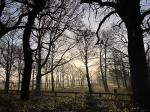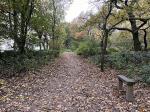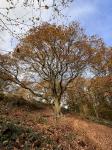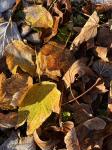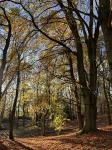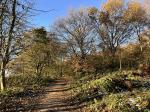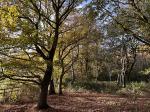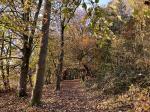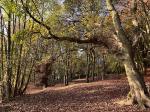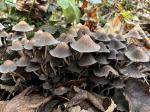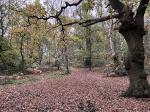Brayton Barff Through the Seasons.
Set in the Vale of York, South West of the market town of Selby and between the villages of Thorpe Willoughby and Brayton, lies Brayton Barff, a sandstone Hill approximately one hundred and fifty feet in height which was formed by glacial movement during the last Ice Age. It is a significant landmark in an otherwise flat landscape.
Today the site is primarily owned by Yorkshire Water with Selby District Council owning a small patch of the land adjacent to the A63 Selby bypass. A large underground reservoir occupies the centre of the site which delivers water to around 4.7 million customers throughout Yorkshire.
Within the Barff woodland over 40% of the trees are Sessile Oak which are generally found in semi natural woodlands in the north of the country. These trees are so called because its acorns are not held on stalks, like those of the English Oak (Pedunculate), but attached directly to the outer twigs. There are also several English Oak trees as well as some cross-hybrid oaks. These trees are known to support many species of flora and fauna, invertebrates, mosses, lichen and fungi.
During the Victorian times it is thought that the shipbuilders on the east coast would come over to the Barff for selected cuts of timber to build their sea going vessels.
The Barff also has a variety of other trees including Silver Birch, Beech, Sycamore, Holly, Rowan, Scots Pine, Alder, Hawthorne and European Larch. There are also several Yew, Willow, Hazel, Horse Chestnut and Wych Elm. As with similar woodlands there are a variety of bushes, including Honeysuckle, Elderberry, Gorse, Broom and Buddleia.
The history of Brayton Barff is quite vague, apparently during 1803 a beacon was lit on the Barff when the country was threatened with an invasion by Napoleon. In May 1935, to celebrate King George V's Silver Jubilee, a Bonfire was lit on the Barff as part of the celebrations.
Early issues of Ordnance Survey Maps dated 1903 clearly show a rifle range on the Barff, extending out to Mill Lane. During the 
Between 2001 – 2004 the A63 Selby bypass, 10km twin lane single carriageway was constructed which severed the South West corner of the Barff, adjacent to Selby Golf Course and resulted in a slight redesign of several holes on the golf course. Wooden fencing was erected as a result of this new road running alongside of the Barff and a footbridge constructed over the ‘new road’ following the line of the Bridal way which extends from Mill Lane. Around 2005/2006 a definite 2metre wide limestone aggregate footpath was laid forming a circular path around the outer edges of the woodland. This footpath is approximately 1.2 miles in length and takes about 30 minutes to circumnavigate at a leisurely pace.
In 2012 the Barff was declared an Ancient Oak Woodland and as such throughout 2012 and 2013 significant work had been carried out by the relevant agencies to cut and remove large swathes of non-native trees, creating at that time huge scars on the landscape. Some three years later the planting of the native trees have become well established and are flourishing. Ongoing maintenance work on the footpath around the bottom of the Barff was completed during the Summer of 2016.
A second phase of woodland maintenance commenced during the Autumn of 2019 with the removal of many old and diseased trees and the cutting back of the Gorse and Broom bushes, especially adjacent to the ‘bypass trail’, this work continued through till March 2020 with re planting continuing into April 2020.
Brayton Barff is a popular site for walkers and bird watchers alike and a path circling the outer perimeter of the Barff makes a pleasant thirty minute walk, giving views looking over towards Selby and the village of Brayton as well as the power stations of Drax and Eggborough..jpg)
For the early risers it is a great place to see some stunning sunrises over the villages of Brayton looking towards Drax Power Station, the same with the Sunsets looking over towards Eggborough and Monk Fryston.
The Barff changes with the Seasons and every visit can reveal something new, the woodland is a haven for wildlife. Records show that since 1982 one hundred and twelve species of bird have been seen in the woodland and at least 40 of those have bred here, including Tawny Owl, Buzzard, Green Woodpecker, Spotted Flycatcher, Goldcrest and Nuthatch to name just a few. On average over 70 species of bird are recorded each year. Further details of the bird life on the Barff can be found on the Brayton Barff Group Facebook page, especially the posts from Derek Cooper. Today ‘The Friends of Brayton Barff group’ led by Derek and a small team of volunteers help keep and maintain the cleanliness of the site as well as recording the wildlife and bird sightings.
The Barff is also home to fifteen different species of mammals, including Muntjac Deer, Pipistrelle Bat, Fox, and Field Vole.
Over eighty species of plant and wildflowers have been recorded, included Bee Orchid, Northern Marsh Orchid, Wood Anemone, Marsh Ragwort, Bluebell, White Bluebell, Bittersweet and Purple and White Foxgloves. Over twenty species of Butterfly have been recorded, including Marbled White, Brown Angus, Speckled Wood, Comma and Brimstone.
During the Autumnal months fungi thrives in this woodland environment, species including Fly Agaric, Beefsteak Tree Fungi, Chicken of the Wood, Sulphur Tufts, Stinkhorn, Ink cap, Puffballs and Hoof Bracket are just some of the many varieties that can be found here.
Click on the galleries shown below to expand the albums.
November 2024
Well, what a dull, cloudy and overcast start to the month. For the first week it has been dull, dry and overcast and misty every morning with the sun finally breaking through the gloom for a few minutes much later in the day, Morning temperatures this first week have varied between 8 – 10c rising to 13 – 14c in the afternoon. Fortunately, the Autumnal colours have been quite spectacular. Robin and Wren are still very vocal and Long Tailed Tits very chatty, especially along the Bypass trail. Clusters of Fungi keep shooting up overnight to catch you by surprise.
A report recently in the Yorkshire post stated that the ‘anticyclonic gloom’ which has left some parts of the uk with virtually no sunshine for more than a week is due to clear from tomorrow the 10th. Researchers say that the gloom occurs when high pressure traps a layer of moisture near to the earth’s surface and that brings a prolonged period of dull and cloudy weather but accompanied with pockets of mist and fog. So far this month, the uk has only had five per cent of the average sunshine expected for November.
What a difference the second week in November was compared to the dull cloudy and overcast weather we have just had from the start of November. Monday 11th was a bright, dry and sunny morning with a light touch of frost. But what a difference the sunshine made; it certainly lifted my spirits. The sunshine stayed with us for the remainder of the week. The Barff certainly put on an amazing show of autumnal colours whilst bathed in the sunlight. The Buzzard has been active as have the Grey Squirrels which of late have been relatively quiet, I have heard them most mornings busily chattering away to themselves high up in the trees. Robin, Wren, Long Tailed Tits and Goldcrest are still very vocal around the woodland. I still haven’t heard any of our winter visitors, Redwing, Waxwings, Bramblings or Fieldfare, though I am certain they have arrived but as yet have eluded me, the Mistle Thrush has been quite vocal though, it’s dry chattering ‘Krrrr’ is quite distinctive, especially when alarmed. Monday 18th November, we woke to our first significant frost of the year and the temperatures plummeted to single figures during the week. On Tuesday 20th we woke to a light covering of snow between a half an inch to one inch deep in places. This had all but melted by lunchtime but with mid-day temperatures around 3c patches of snow lasted in the sheltered places for the rest of the week. Birdsong was quite muffled with the colder temperatures, Robin and Wren were stopping indoors but Long Tailed Tits, and Goldcrest could be heard around the woodland all week. We have had a fresh covering of fallen leaves on the woodland floor daily, accelerated by the overnight frosts and chilling westerly breeze. The Autumnal colours have been beautiful this week, especially around the old firing range, the woodland here being covered in a huge golden blanket of fallen leaves. Thursday 21st the temperature plummeted to -4c at 7.00am.
Storm Bert arrived in the early hours of Saturday morning (23rd), we actually had an overnight frost that morning but once the rain started it brought with it much warmer temperatures, 14c at lunchtime, unfortunately we had over twenty-four hours of none - stop rain which eventually stopped mid-morning on the Sunday. Weather forecasters predicted that a months’ worth of rain had fallen in the last twenty-four hours. Fortunately, we never saw any snow or flooding, unlike other parts of the county. By Monday (25th) storm Bert had all but gone from the county and the last week of the month saw colder temperatures with overnight frosts and bright sunny cold days with the temperature stopping in single figures for most of the time. Robin, Wren, Goldcrest, Long Tailed Tits and Goldfinches have all been very vocal along with our resident pair of Buzzards. Grey Squirrels have been very active chattering away to themselves in the trees as well as scampering through all the freshly fallen leaf litter. The Autumn colours have been beautiful in the morning sunlight. Alas as the month comes to an end only a few leaves are left on the trees and the Barff continues to protect itself for the cooler winter months ahead.
|

